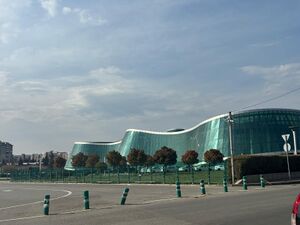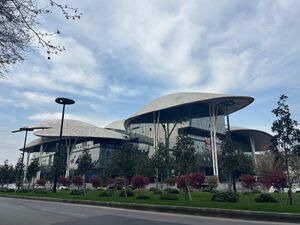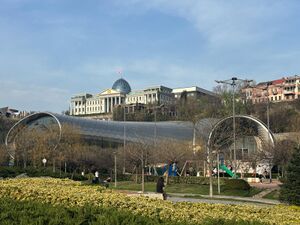The architectural blend of Tbilisi: a dialogue between past and future
| Title | The architectural blend of Tbilisi: a dialogue between past and future |
|---|---|
| Author | Paola Santaniello, Eleonora Cozzolino |
| Date | 2024-04-22 |
| Project | 2024-1-IT03-ESC51-VTJ-000227786 |
The architecture of Tbilisi, the capital of Georgia, reflects the contradictions and multiple influences of its past, where elements of ancient civilizations, traditional characteristics, remnants of the Soviet era, and contemporary trends coexist.
Especially in the last twenty years, the country has embarked on a path of affirming its own identity, also through the strengthening of a pro-European sentiment. Proximity to Europe is also evident in contemporary architecture, which has recently been entrusted to two internationally renowned Italian architects who have left a visible mark on the Georgian urban landscape. Without losing sight of the country's historical and cultural essence, the Georgian government has sought to combine elements of modern design with more strictly traditional ones. Thus, it is possible to walk through the streets of Tbilisi and encounter characteristic wooden houses, of various colors, interspersed with structures that are decidedly more avant-garde, mainly in steel and glass. The city's streets thus reveal a matured interest in more sustainable architecture that seeks to safeguard the city's historic buildings, often readapting their use.

Following this spirit, in the aftermath of the 2003 Rose Revolution, the then newly elected President Saakashvili turned to the Ferrara-born architect Michele De Lucchi with the aim of giving Georgia a more European image. Born in 1951, the Italian architect graduated in Florence in 1975 and established himself during the period of radical and experimental architecture as a prominent figure in movements like Cavart, Alchymia, and Memphis. De Lucchi's contribution is primarily evident in the redesign of the Rike district with the construction, begun in 2004 and completed in 2009, of the new Presidential Palace. The building, once the residence of President Saakashvili, later became the headquarters of a new American university when his successor Margvelashvili decided to move elsewhere in 2013. A not always mentioned aspect concerns the construction of the dome, inspired by the Reichstag in Berlin; it is no coincidence that the latter was built in Germany based on the project of the Georgian architect Vakhtang Zesashvili and the Italian architect Franco Zagari.
De Lucchi's works also include the modern Ministry of Internal Affairs Palace along the Kakheti highway, a structure completely covered in glass that resembles the shape of an undulating ribbon, completed in 2008.

The same author is also responsible for the Peace Bridge. Although most of the Georgian population has never accepted its construction, considering it excessively modern and too much in contrast with the historical buildings that characterize the Old Town, the bridge remains an undeniable symbol of the city and a major tourist attraction. Spanning the Mtkvari River, the structure connects the historic Bericoni district in the West with the Rike district in the East. Furthermore, this architectural element holds a little-known curiosity, hidden in the flashing lights that illuminate the bridge in the evening. These, in fact, send a message in Morse code every hour. Philippe Martinaud, the creator of this effect, selected elements from Mendeleev's Periodic Table that are naturally present in the human body and subsequently translated them into Morse code to transmit the message to passersby: tourists and citizens mostly unaware of its existence. Martinaud's intention, in his own words, is to transmit a constant hymn to life and peace among peoples and nations. The bridge, with a pedestrian walkway and a sinusoidal roof seemingly suspended on four pillars over the river, symbolizes the dialogue between the past and the present, of a country that feels the need to look forward without forgetting its history and identity. This relationship between the two cultures has given life to unique and fascinating works that mix traditional Georgian elements with Italian techniques and styles.

Another Italian contribution to Tbilisi's architecture was provided by the Roman designer Massimiliano Fuksas, an architect by training, whose work also spans the fields of urban planning and design. In the Georgian capital, the first structure created by the Roman was the Tbilisi Public Service Hall, completed in 2012, and now home to various administrative offices. The building, also known as the House of Justice, is located in the city center along the Mtkvari River, and is composed of seven glass-covered cantilevered volumes, with a large central square that houses various front-office services. Also nicknamed "the umbrellas," the structure includes the National Bank of Georgia, the Ministry of Energy, and the Civil and National Registry. The headquarters were conceived to bring together almost all the administrative and bureaucratic offices that citizens need in a single space. The functionality of the structure is also reflected in the organization of the spaces, designed to minimize waiting times. Three areas differentiated based on the time required to obtain what is needed, ensure efficient service for citizens.

Another work by the Roman architect, completed just recently, is the Music Theatre and Exhibition Hall, located in Rike Park, renovated by De Lucchi a few years earlier. The building consists of two shaped volumes with flowing lines, connected as a single body to a retaining wall. Each volume corresponds to a function: one houses a 566-seat auditorium, the foyer, technical rooms for machinery, and some storage; while the other houses a large exhibition center which can be accessed directly from Rike Park via a flight of stairs.
All these works represent a combination of tradition and modernity, giving Tbilisi a unique and cosmopolitan identity and testifying to the country's desire to look to the future without forgetting its roots.

Bibliograoghy and sitography
- N. š. Džanberidze, I. N. Cicišvili, "Architektura Gruzii"
- "Gruzinskaja Architektura perechodnogo perioda"
- V. V. Beridze, "Architektura Gruzii IV-XIX veka (Očerki po istorii architekturj narodov SSSR)" - 1948
- eastjournal.net/archives/74667
- tourismconnection.it/en/georgia-architettura-italiana-a-tbilisi
- nationalgeographic.com/travel/article/paid-content-architectural-tour-tbilisi-georgia
- archiportale.com/news/2011/01/architettura/tbilisi-il-ponte-della-pace-di-michele-de-lucchi_21137_3.html
- lonelyplanet.com/georgia/tbilisi/attractions/public-service-hall/a/poi-sig/1524455/359327
- fuksas.com/tbilisi-service/
- tbilisilocalguide.com/tbilisi/tbilisi-public-service-hall/
- georgianweb.com/the-bridge-of-peace-tbilisi-georgia-10-fascinating-facts/









